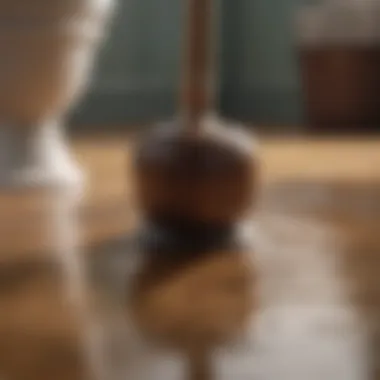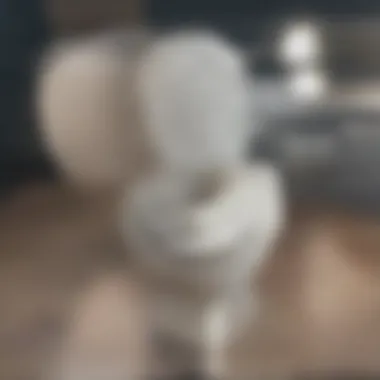A Practical Guide to Unclogging Your Toilet


Intro
Dealing with a clogged toilet can be an inconvenient and stressful situation for any homeowner. Understanding the causes of blockages and how to address them quickly can save time and potentially avoid costly plumbing bills. This guide walks through various methods for unclogging toilets, the essential tools needed, and preventative measures. It is tailored for both simple and complex clogs, ensuring that readers can handle whatever issue arises.
Feature Spotlight
Key Methods to Unclog Your Toilet
There are several methods for unclogging a toilet, each suited to different types of blockages. Here are the most effective approaches:
- Plunging: The most common method, using a plunger specifically designed for toilets, creates suction to dislodge the clog.
- Snaking: A toilet auger or snake can reach deeper blockages, extending through the trap. It’s especially useful for foreign objects that may have fallen into the toilet.
- Homemade Solutions: Mixtures like baking soda and vinegar can dissolve minor clogs over time. This method is more natural and can be less abrasive than chemical solutions.
- Wet/Dry Vacuum: If you have access to a wet/dry vacuum, it can be effective for removing water and debris from the bowl.
Each method can be effective depending on the nature of the blockage and the situation.
In any case, avoid flushing multiple times as it may cause the toilet to overflow and create further issues.
Tools of the Trade
To effectively tackle a clogged toilet, certain tools are essential:
- Plunger: A good-quality toilet plunger is non-negotiable. Make sure it offers the right shape and suction power.
- Toilet Auger: This tool is perfect for breaking up or retrieving stubborn clogs deeper in the toilet's plumbing.
- Rubber Gloves: For hygiene, wearing rubber gloves during the unclogging process is advisable.
- Bucket: Useful for managing excess water if you need to remove it before unclogging.
- Baking Soda and Vinegar: A natural solution for minor clogs, these materials often work well in tandem.
These tools streamline the unclogging process and make it more manageable.
Preventative Maintenance
To minimize the risk of future clogs, regular toilet maintenance is key. Here are some measures to consider:
- Mind What You Flush: Only toilet paper and human waste should be disposed of in the toilet. Items like paper towels, feminine hygiene products, and dental floss can cause severe clogs.
- Regular Cleanings: Using a toilet brush and cleaner can prevent buildup from creating more serious blockages.
- Check for Issues: Regularly inspect the plumbing for leaks or signs of deterioration that could indicate potential problems.
Adhering to these tips not only helps maintain your toilet but also extends its lifespan.
Ending
Unclogging a toilet may seem daunting, but with the right methods and tools, it becomes a more manageable task. Understanding how to address various types of blockages can alleviate the stress associated with plumbing issues. By following preventative measures, homeowners can enjoy a smoothly functioning toilet and avoid future problems.
Understanding Why Toilets Clog
Understanding why toilets clog is crucial for effective maintenance and prevention. A clogged toilet can disrupt daily life, causing inconvenience and frustration. By gaining insights into the underlying issues, homeowners can take proactive steps to minimize blockages. This knowledge empowers individuals to address minor issues before they escalate, potentially preventing costly plumbing repairs.
Common Causes of Toilet Clogs
Several factors contribute to toilet clogs, and recognizing these can help in effective management.
- Excessive Toilet Paper: Using more toilet paper than necessary is a frequent cause. Toilets are designed to handle a specific amount, and overloading can lead to blockages.
- Foreign Objects: Items such as toys, feminine hygiene products, or wipes are often flushed mistakenly, leading to severe clogs.
- Natural Debris: In older homes, roots from nearby trees can intrude into sewer lines. This is less common but can create significant problems.
Understanding these common causes fosters better habits regarding what can safely be discarded in the toilet.
Impact of Flushing Improper Items
Flushing items not intended for toilets can have serious consequences. Many people mistakenly believe that household items can be disposed of this way without trouble. However, the impact extends beyond mere clogging:
- Increased Repair Costs: Improper flushing often results in expensive plumbing services.
- Environmental Concerns: Items are often not biodegradable, leading to larger waste management issues.
- Health Hazards: Clogs can create unpleasant odors and unsanitary conditions in homes.
Educating all household members on proper disposal methods is essential to prevent these issues.
Where Clogs Typically Form


Understanding where clogs typically form in a toilet can assist in diagnosing issues quickly. The common points include:
- Toilet Trap: Most clogs occur in the toilet trap, a curved section designed to hold water and block odors.
- Drainage Pipe: Residue and build-up can accumulate in the pipes leading from the toilet, especially if issues reside further down the line.
- Sewer Line: In rare cases, the sewer line can be the source of blockage, affecting multiple drainage systems in the house.
By understanding these critical points, homeowners can adopt targeted measures for unclogging and maintenance.
Essential Tools for Unclogging
Unclogging a toilet can often be a frustrating task, but having the right tools makes a significant difference. Understanding the essential tools helps improve efficiency and effectiveness in dealing with blockages. Each tool serves a specific purpose and can tackle different types of clogs. Knowing what to use can save time and prevent further complications in your plumbing system.
Type of Plungers Available
Plungers are a fundamental tool for unclogging toilets. Not all plungers are created equal. There are primarily two types of plungers that are most useful for toilet clogs:
- Cup Plunger: This is the basic design. Its rubber cup creates suction when pushed down into the toilet bowl. It is effective for shallow clogs. However, it might struggle with deeper blockages.
- Flange Plunger: This has an extended rubber flap, or flange, below the cup for sealing better to the toilet's drain. This type gives more effective suction, making it ideal for toilets. Its specialized design assists in removing both minor and more serious clogs.
Having both types can be beneficial. In many situations, the flange plunger will likely be the tool of choice for toilet-related clogs. It is crucial to use the right one for the job to avoid damaging the toilet.
Using a Toilet Auger
A toilet auger, or a plumber’s snake, is a tool designed for more stubborn clogs that plungers cannot resolve. It consists of a long, flexible wire that can navigate through the curves of the toilet drain and reach blockages that are further down the line.
To use a toilet auger:
- Insert the end of the auger into the toilet bowl and push it gently down the drain.
- Crank the handle to extend the cable. This movement allows the wire to break up the clog or hook onto it.
- Once you feel resistance, continue to turn the handle to dislodge the blockage. Be careful when pulling the auger back out. Clean it properly after use to maintain hygiene and prolong its life.
The toilet auger is particularly useful when it comes to debris not cleared by plunging. Always wear gloves when handling to avoid contact with waste.
Chemical Drain Cleaners: Pros and Cons
Chemical drain cleaners are another option to remove clogs. They contain powerful chemicals that dissolve blockages, making them effective in many cases. However, they have notable pros and cons.
Pros:
- Quick and easy application. Simply pour the cleaner down the toilet and wait as per the instructions.
- Effective against certain types of clogs, especially grease or soap buildup.
Cons:
- Harsh chemicals can damage pipes over time.
- Unsafe for toilet components, such as seals and gaskets.
- Potentially hazardous to health.
- Environmental concerns due to chemical runoff.
Using chemical cleaners should be a last resort. Consider the long-term effects on plumbing. Always follow the manufacturer’s instructions and safety precautions.
"Choosing the right tools can be the difference between a frustrating experience and a smoothly resolved issue."
In summary, being aware of the various essential tools for unclogging toilets allows homeowners to respond effectively to plumbing challenges. Understanding plungers, toilet augers, and chemical drain cleaners prepares one for a variety of clogs and helps maintain a functional toilet.
Initial Assessment Before Unclogging
Before jumping into unclogging a toilet, it is essential to conduct an initial assessment. This step is pivotal as it determines the best approach for resolving the issue without causing further complications. Understanding the clog's severity and the specific signs of a problematic toilet helps to tailor the techniques to apply. Not all clogs require the same method; some may be easily resolved with a plunger, while others may need more advanced tools like a toilet auger or even professional help.
Identifying the Severity of the Clog
To commence this initial assessment, one needs to identify the severity of the clog. Generally, clogs can range from mild to severe. A mild clog often manifests with slow drainage or occasional backups. In contrast, a severe clog can lead to a completely non-functioning toilet, where water does not drain at all.
To evaluate the severity:
- Observe the Water Level: If water is rising towards the rim, the clog is likely severe.
- Test the Flush: If flush attempts result in an immediate backup, this indicates a significant issue.
- Check for Blockages in Other Fixtures: If multiple toilets or drains across the house are affected, it suggests a more extensive plumbing problem.


Recognizing these indicators gives insights into what methods may be effective. Knowing if the clog is severe can prevent unnecessary labor with ineffective tools.
Recognizing Symptoms of a Problematic Toilet
Awareness of other symptoms can guide the assessment process effectively. A problematic toilet will often exhibit various signs that hint at underlying issues. Here are some common symptoms:
- Frequent Clogging: If the same toilet clogs repeatedly, it may indicate a deeper problem rather than just a one-time occurrence.
- Strange Noises: Gurgling or hissing noises while flushing can point to air trapped in the plumbing.
- Unpleasant Odors: Foul smells might suggest waste accumulation or stagnation caused by excessive clogs.
These symptoms warrant close attention to avoid escalating problems. By identifying the severity and recognizing symptoms early, homeowners can choose the right unclogging technique, saving both time and frustration.
Always begin with a thorough assessment. Skipping this step can lead to increased issues down the line, making a simple clog a far more complicated situation.
Simple Methods to Unclog a Toilet
Clogged toilets can disrupt daily life, causing frustration and inconvenience. Understanding simple methods to unclog a toilet is crucial for homeowners. Effective unclogging methods can save time and avoid potential damage or costly repairs. There are approaches using common household tools and items, making them accessible and easy to implement.
Using a Plunger Effectively
Toilet plungers are essential tools for homeowners. The right technique can greatly enhance the effectiveness of using a plunger. Here’s how to use it properly:
- Choose the Right Plunger: Ensure you are using a flanged plunger. This type is designed specifically for toilets.
- Position the Plunger: Place the plunger over the drain hole, ensuring a tight seal.
- Push and Pull: Start with gentle pressure, then increase the intensity. Push down slowly, then pull up quickly. Repeat this motion without breaking the seal. The suction and pressure should help dislodge the blockage.
Using persistence can result in clearing minor to moderate clogs effectively. It's a quick first step before trying more complicated methods.
Hot Water and Dish Soap Technique
This method combines temperature and lubrication, often proving effective for soft clogs. The heat can help break down grease or soap build-up blocking the pipes. Here’s how to execute this technique:
- Prepare Hot Water: Heat water to near boiling but do not let it reach a boil.
- Add Dish Soap: Pour some dish soap directly into the toilet bowl. Allow it to sit for a few minutes. The soap will act as a lubricant.
- Apply Hot Water: Gradually pour hot water into the toilet bowl from waist height. This strategy increases the pressure and can break down the clog further.
This method works best for clogs caused by non-solid items and is a gentle approach.
Baking Soda and Vinegar Approach
This is a simple yet effective natural method for certain clogs. The chemical reaction between baking soda and vinegar can help clear blockages due to its fizzing action. To use this technique:
- Add Baking Soda: Pour one cup of baking soda into the toilet bowl.
- Add Vinegar: Follow it with two cups of vinegar. The combination will start to fizz.
- Let it Sit: Allow the mixture to sit for about 30 minutes. This will give it time to work on the clog.
- Flush: After 30 minutes, flush the toilet to see if the clog has cleared.
This method utilizes common household products and is environmentally friendly, along with being cost-effective.
Remember, regular toilet maintenance can prevent clogs before they become problematic.
These simple methods provide quick solutions to unclogging toilets. Each method has its specific strengths and applications, making it easy for any homeowner to choose the right approach for their situation.
Advanced Techniques for Stubborn Clogs
When faced with a stubborn clog, simple methods like plunging or using hot water may not suffice. Understanding advanced techniques is essential. These methods are designed for persistent blockages that resist standard unclogging approaches. Knowing when and how to use these techniques can save time and reduce frustration. They often provide a reliable solution for toilets that are repeatedly clogged. Moreover, using these methods correctly minimizes the risk of damaging the plumbing.
Using a Toilet Auger: Step-by-Step
A toilet auger can be a crucial tool in resolving stubborn clogs. Here is the guided approach to using one effectively:
- Gather Required Tools: Ensure you have a toilet auger ready. It usually contains a long cable that can reach deep into the pipes.
- Position the Auger: Start by inserting the auger's end into the toilet bowl, carefully guiding it into the drain opening without causing damage.
- Crank the Handle: Once secure, begin cranking the handle slowly. This motion helps the auger navigate through any blockages, displacing the debris.
- Feel for Resistance: Keep cranking until you feel a change in resistance. This suggests that the auger has either cleared the clog or reached a more difficult blockage.
- Extract the Auger: Once you've cranked through the clog, slowly pull the auger back out. Be cautious of any debris that may come with it.
- Flush the Toilet: Finally, flush the toilet to check if the blockage has cleared. A successful flush indicates that the method worked.
"Using a toilet auger may seem daunting, but it is one of the most effective methods for removing tough clogs without causing damage."
Chemical Drain Cleaners: Application and Safety


Chemical drain cleaners can serve as a powerful alternative for dealing with stubborn clogs, but they come with important safety considerations. Here’s an overview of this approach:
- Types of Cleaners: Familiarize yourself with various chemical drain cleaners available, such as sodium hydroxide or sulfuric acid based options. Each type has different effectiveness based on the nature of the clog.
- Proper Application: Follow the instructions carefully when using these products. Pour the recommended amount into the toilet bowl, ensuring it sits long enough to dissolve the blockage.
- Safety Precautions: Protect yourself. Always wear gloves and goggles when handling chemical cleaners. Ensure proper ventilation in the bathroom, as fumes can be hazardous.
- Risk of Damage: Understand that these cleaners can be corrosive. Regular use or incorrect application may damage pipes, particularly older plumbing.
- Avoid Mixing Products: Never mix different types of drain cleaners, as it can result in dangerous reactions. Stick to one product at a time.
Preventative Measures for Future Clogs
Preventing clogs in your toilet involves understanding both routine maintenance methods and educating all household members about proper usage. These steps minimize the chances of blockages and enhance the longevity of your plumbing fixtures.
Routine Maintenance for Your Toilet
Routine maintenance is crucial for preventing clogs from developing in the first place. Regular checks and simple maintenance tasks help identify potential issues while they’re still manageable. Here are some effective maintenance practices:
- Regular Cleaning: Clean your toilet regularly using a toilet brush and appropriate cleaners. This approach not only maintains hygiene but also helps prevent buildup.
- Inspect Components: Examine the flush and fill mechanisms periodically. Look for signs of wear or malfunction. Sometimes, a faulty flapper or fill valve can lead to more significant problems.
- Test for Leaks: A dye test can help determine if there are leaks in your toilet. Add a few drops of food coloring to the tank. Wait about 15 minutes and see if the color appears in the bowl without flushing.
- Examine the Tank Water Level: Ensure that the water level in the tank is correct. A water level that is too low may not provide enough force to effectively flush waste down the pipes.
- Know Your Water Usage: Limit the use of excessive toilet paper or disposable items meant for the wastebasket. Understand that what goes into your toilet impacts its function.
Educating Household Members on Proper Use
Education plays a key role in toilet maintenance. All members of the household should be well-informed about what can or cannot be flushed. This knowledge can prevent many issues before they arise. Here are some important points to cover:
- Flushable Items Only: Emphasize that only bodily waste and toilet paper should be flushed. Items like wipes, feminine hygiene products, and paper towels should never go into the toilet.
- Children’s Awareness: Teach children from a young age about the function of the toilet and what is appropriate to flush. Simple lessons can help prevent them from experimenting.
- Discuss Emergency Procedures: Educate everyone on what to do if something gets flushed by mistake. This includes using a plunger or notifying an adult for assistance.
- Setting a Good Example: Model proper use of the toilet. Adults should demonstrate correct practices, reinforcing these behaviors for children and other household members.
"Preventative measures take only a bit of time but save significant amounts of effort and stress down the line."
By focusing on routine maintenance and educating all users, you can greatly reduce the chances of dealing with toilet clogs. Taking these preventative measures protects your plumbing system, ensuring fewer disruptions and promoting a smoother, more efficient toilet operation.
When to Call a Professional
Understanding when to seek professional help is crucial for homeowners dealing with toilet issues. Recognizing the limitations of DIY methods is essential. While many clogs can be resolved with household tools, some require specialized expertise. Knowing the right time to call a plumber can save both time and money, preventing further damage to your plumbing system.
Several factors influence this decision. Complexity of the clog is one of the major elements. If simple methods fail, it may indicate a deeper issue. Additionally, an ongoing problem that recurs after multiple attempts at fixing it is not just a nuisance; it reveals underlying plumbing problems that need professional intervention. Ignoring these signs can worsen the situation. This may result in higher repair costs and inconvenience.
Signs Indicating Professional Help is Needed
Several signs indicate that it's time to call a professional plumber. Noticing any one of these can help you determine the need for expert assistance:
- Persistent Clogs: If multiple attempts to unclog your toilet fail, it may suggest a significant obstruction further down the pipes.
- Frequent Backups: Continuous backups, especially in other drains, can signify systemic plumbing issues.
- Unusual Sounds: Gurgling noises from other fixtures indicate pressure changes within the plumbing, hinting at blockages.
- Foul Odors: An unpleasant smell coming from the toilet or nearby drains is a clear sign of possible sewer issues.
- Water Level Fluctuations: If the water level in your toilet bowl changes significantly without flushing, it could indicate a blockage or venting issue.
If you observe any of these conditions, it is wise to call a professional rather than risk further complications.
Understanding the Role of a Plumber
Understanding what a plumber offers can make it easier to decide when to call one. Plumbers are trained professionals equipped to handle various plumbing problems. They utilize specialized tools and technology to diagnose and resolve issues that homeowners might not have access to.
Their services can include:
- Camera Inspections: Plumbers often use cameras to inspect pipes for blockages or damages that are not visible externally.
- Advanced Techniques: They can conduct hydro-jetting or use mechanical snakes to resolve persistent clogs safely.
- Expert Consultation: Plumbers can provide insights into preventive measures and efficient plumbing system maintenance.
End: Mastering Toilet Maintenance
Toilet maintenance is crucial to ensuring the longevity and functionality of one of the most essential fixtures in any home. A clogged toilet is not just a nuisance; it can lead to more extensive plumbing issues if not addressed promptly. Therefore, understanding how to maintain your toilet effectively allows for a smoother experience in dealing with everyday use.
Summary of Key Techniques
Several techniques can be employed to keep a toilet functioning optimally. Here is a recap of effective methods:
- Routine Inspection: Regular checks for leaks, cracks, or malfunctions in the flushing mechanism can prevent unexpected clogs.
- Proper Flushing Habits: Only flush items that are toilet-friendly. Wipes, feminine products, and excessive toilet paper should be disposed of in the bin instead of flushed.
- Use of Plumbing Tools: Investing in a quality plunger and a toilet auger can make a significant difference. Being equipped when a clog occurs ensures that you can respond quickly.
- Occasional Deep Cleaning: Utilizing baking soda and vinegar for cleaning not only maintains hygiene but can also help in breaking down buildup in the pipes.
Importance of Proactive Care
Proactive care is essential for avoiding future problems. A few practices to consider include:
- Education on Usage: Informing all household members about what can and cannot be flushed reduces the chances of improper use.
- Scheduled Maintenance: Periodically scheduling a plumber visit can catch problems before they escalate and create more significant damage.
- Adopting Good Habits: Make it a habit to regularly check water levels and inspect for leaks. Early detection can prevent more severe plumbing issues later on.
"An ounce of prevention is worth a pound of cure."







